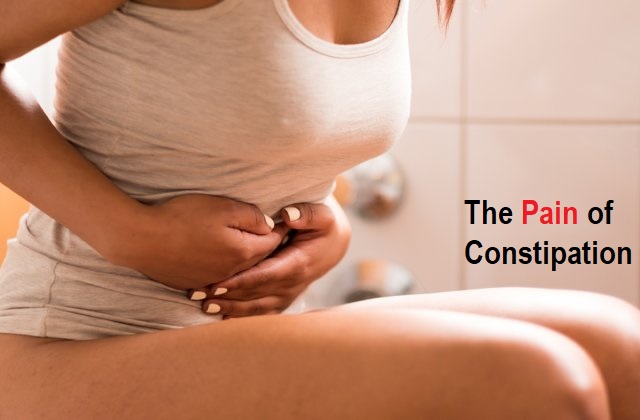
Studies suggest 1 2 that around 20% of people in Westernised countries suffer from constipation. That’s a lot of unpleasant and largely unnecessary toilet trouble by any standards. But is there a simple, drug-free remedy? You can bet your beans and greens there is!
Blog Contents
Fibre, fibre, fibre
The most common lifestyle choice associated with the development of constipation is eating a low-fibre diet.
It still comes as something as a surprise just how many people are completely unaware that fibre can only be found in foods derived from plants – fruit and veg, beans, whole grains, etc – and that there is ZERO fibre in meat, dairy products, and eggs.
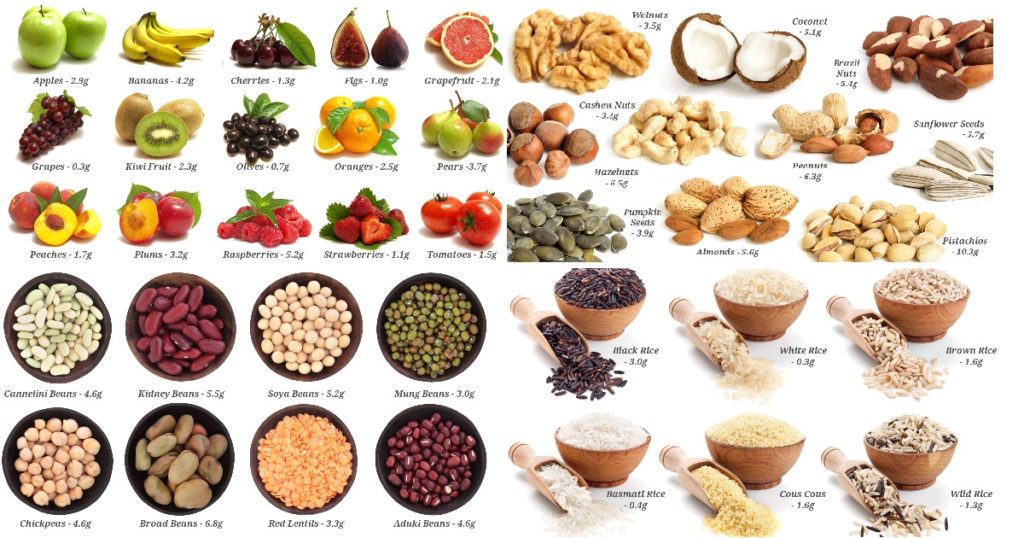
The average daily fibre intake in the UK is 17.2 grams/day for women and 20.1 grams/day for men, with a government recommendation of a minimum of 30 grams/day 3 . In the US, the recommendations vary from 19-38 grams/day, whilst US fibre intake is even less than the UK, at around 16 grams/day 4 5 . And, because these are averages, it means there are plenty of people eating considerably less than this.
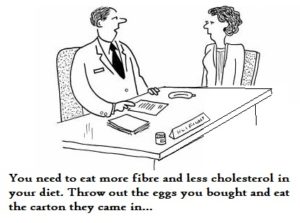 A previous blog 6 discussed fibre in more detail, and pointed out that eating as much as 100 grams of fibre daily was quite normal in earlier human evolution.
A previous blog 6 discussed fibre in more detail, and pointed out that eating as much as 100 grams of fibre daily was quite normal in earlier human evolution.
In those countries where traditional diets contain much more fibre, it’s no surprise to find that constipation is much less common. But how can we know that it’s the fibre that’s making so much difference? Well, studies have looked at the changes that occur when such countries adopt the modern Western diet, which is much lower in fibre content. And what they’ve found is that constipation prevalence increases. 7 8
Constipation by country
There’s a very detailed list of reported constipation cases available at cureresearch.com 9 , but the following selective chart from a 2008 study 10 shows a common finding: namely, that women tend to suffer more than men.
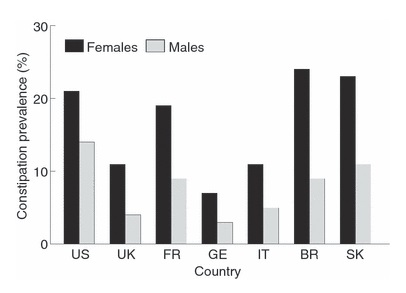
Problems arising from constipation
There are a number of complications which may arise from constipation 11 12 , including:
- haemorrhoids (from “straining at the stool”)
- anal fissures
- rectal prolapse
- faecal impaction (also called malignant constipation), which may lead to:
- bowel obstruction
- nausea
- vomiting
- tender abdomen
- encopresis (where soft stool from the small intestine bypasses the impacted faecal mass in the colon)
How to prevent and alleviate constipation
It’s pretty obvious that the most sensible and natural method will involve increasing fibre content in the diet.
 In children, studies show 13 14 that a lower intake of dietary fibre differentiates children with chronic constipation from those who have regular bowel movements. It’s so sad that children have to undergo such suffering simply because their parents and carers fail (whether through ignorance or conscious choice) to feed them a diet that maintains their gut health. Of course, it’s not just the problem of constipation that’s at issue here; maintaining a healthy gut microbiome from early life is vital for overall health through childhood and into old age 15 16 17 18 . And it’s such an obvious yet largely unappreciated fact 19 that our GI tract (along with all the trillions of essential bacteria, fungi and other microbes therein) is best maintained by a whole food plant-based diet rather than a diet of processed and/or animal foods.
In children, studies show 13 14 that a lower intake of dietary fibre differentiates children with chronic constipation from those who have regular bowel movements. It’s so sad that children have to undergo such suffering simply because their parents and carers fail (whether through ignorance or conscious choice) to feed them a diet that maintains their gut health. Of course, it’s not just the problem of constipation that’s at issue here; maintaining a healthy gut microbiome from early life is vital for overall health through childhood and into old age 15 16 17 18 . And it’s such an obvious yet largely unappreciated fact 19 that our GI tract (along with all the trillions of essential bacteria, fungi and other microbes therein) is best maintained by a whole food plant-based diet rather than a diet of processed and/or animal foods.
As would be expected, therefore, additional studies show that increasing dietary fibre improves constipation and significantly reduces the need for laxatives in all societal groups:
When fibre supplementation may be necessary
Naturally, the first and best option is to increase the consumption of high-fibre foods. This is because, by eating whole plant foods, we don’t just facilitate easier gut transit, but the fibre itself and the natural healthy bacteria included with plants act as probiotics and prebiotics for our gut bacteria, and a variety of plants provides a vast array of minerals, vitamins, and an almost inestimable number of beneficial phytochemicals.
However, there are situations where chewing away on fibrous plant food is not an option, and so, in the following cases, fibre supplements may be the best option:
- individuals lacking teeth (edentulism)
- patients who can’t swallow easily or at all (dysphagia)
Prescribing laxatives is a very general knee-jerk reaction of medical professionals. They seem to choose this because they don’t appear to believe their patients have the wherewithal to significantly alter their diets. However, suggesting fibre supplements, in the case of the above two conditions, or changing to a high-fibre diet, in the case of most patients, is far more successful than merely pouring laxatives down your throat while still eating the same constipating diet. When the second best alternative (fibre supplements) are offered, evidence suggests 24 that around 60% of constipated patients can dispense with the laxatives they had been previously taking.
Different types of fibre supplements
The following have been shown to be effective for constipation relief:
- psyllium (Metamucil) 25 (although prunes have been shown 26 to be more effective than psyllium)
- methylcellulose (Citrucel) 27
- Japanese konjac root (glucomannan) 28
But, I repeat, the first and best option is to transition to a plant-based diet (ideally non-SOS WFPB) unless, of course, you have no teeth or cannot swallow easily. And, even the latter two cases, I would suspect that there may be some way found to ensure whole plant foods are eaten, even if they have to be pulped or liquidised to some extent. I have some personal experience of this situation, since my father developed COPD 29 and dysphagia. Being crippled and having to be cared for my my mother, she was told that he would only ever be able to eat pureed food. However, she found that with some careful selection of foods, he was able to eat “solid” food almost until the time of his eventual death.
Dehydration & constipation
Even mild dehydration is a very common factor in cases of constipation 30 31 . This has also been found 20 to be the case in young constipated children. And it’s easy to understand why this is the case, and how it links inextricably with diet, when you realise that whole plant foods contain loads of water, while processed and animal foods can contain considerably less – and also usually contain loads of dehydrating salt.
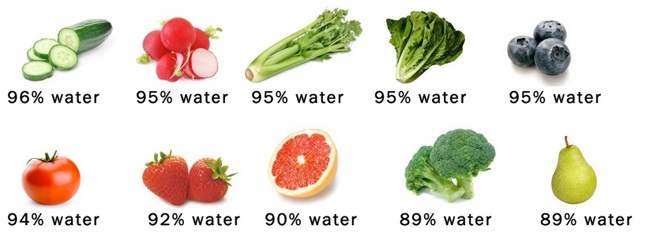
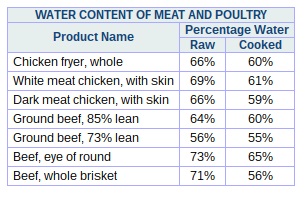
Becoming dehydrated, without being aware of it, is much easier and more widespread than most of us realise. This can be seen from a US study 32 which found a shocking 75% of US citizens were chronically dehydrated.
In patients with functional chronic constipation, it’s been shown 33 that combining fibre and fluid (25 grams and 1.5-2.0 litres, respectively) on a daily basis was more effective for constipation relief than simply taking fibre alone.
It’s no surprise, then, that Dr Greger includes water consumption as one of the essential items in his Daily Dozen list 34 , stating that “…authorities from Europe, the U.S. Institute of Medicine, and the World Health Organization recommend between 2 to 2.7 liters of water a day for women. That’s 8 to 11 cups a day for women, and 10 to 15 cups a day for men. Now but that’s water from all sources–not just beverages–and we get about a liter from food and the water our body actually makes. So these translate into a recommendation for women to drink 4 to 7 cups of water a day, and men 6 to 11 cups, assuming only moderate physical activity at moderate ambient temperatures.” 35 .
Constipation & cow’s milk
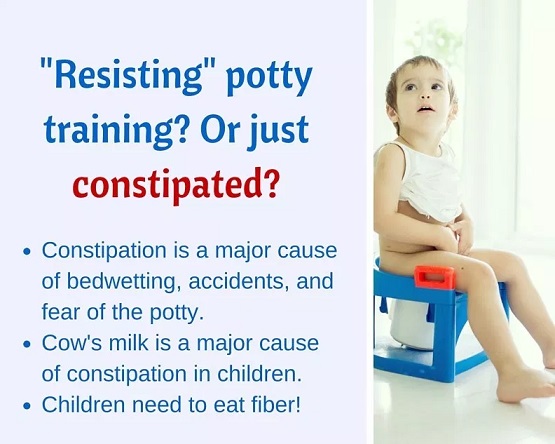 Many children with chronic constipation are found 36 to be allergic to cow’s milk, manifesting IgE antibodies 37 to cow’s milk antigens38 . It’s always worthwhile for parents to ensure that any difficulties occurring during potty training are not associated with constipation resulting from the child drinking cow’s milk.
Many children with chronic constipation are found 36 to be allergic to cow’s milk, manifesting IgE antibodies 37 to cow’s milk antigens38 . It’s always worthwhile for parents to ensure that any difficulties occurring during potty training are not associated with constipation resulting from the child drinking cow’s milk.
This is no insignificant matter, since consumption of cow’s milk has been found 39 to be significantly higher in infants and children with constipation and anal fissure than in those without these disorders.
And it gets even worse. Colonoscopies revealed 40 that around 50% of constipated, cow’s milk-allergic children and adolescents had lymphoid nodular hyperplasia 41 , compared with 20% of controls. The same study also found that around 33% of all cow’s milk-allergic individuals had a significantly higher number of intraepithelial T cells 42 , indicating an enhancement of local immune responses against food antigens. Another study of children with lymphoid modular hyperplasia found 43 that in 43 of the 52 individuals a diagnosis of cow’s milk or multiple food hypersensitivity was made.
Such activation of the immune system is known 44 to affect gastric motility 45 , thus indicating a likely role for an immune response to food antigens in cases of constipation.
Cow’s milk or soy milk?
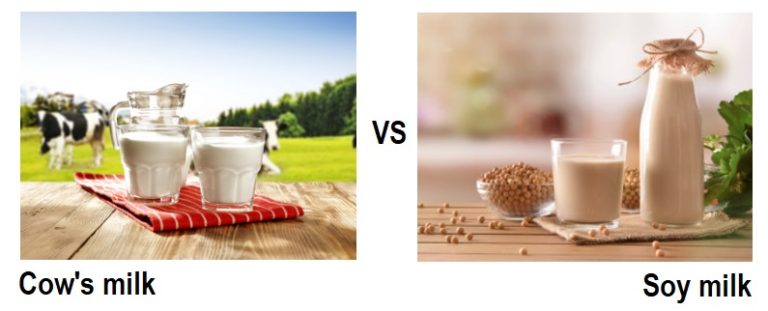 Cutting out cow’s milk totally, in the diets of those children with cow’s milk sensitivity and constipation, has been shown 46 to result in significant improvement in up to 66% of cases.
Cutting out cow’s milk totally, in the diets of those children with cow’s milk sensitivity and constipation, has been shown 46 to result in significant improvement in up to 66% of cases.
In a small-scale study 47 of children with constipation, 100% of the participants had full resolution of chronic functional constipation when soy milk was used as a replacement for cow’s milk.
A further study found 48 that when cow’s milk was reintroduced, constipation returned within 5-10 days.
Previous blogs 49 50 have discussed in much more detail the range of health issues associated with cow’s milk. In basic terms, for all humans, irrespective of age, there’s absolutely no nutritional need for “baby calf growth fluid” 51 to be included in the diet. And, for a significant number of both children and adults who experience constipation, it would seem a sensible plan to try cutting out cow’s milk completely to see whether relief of symptoms follows.
Final thoughts
So, getting lots of fibre, drinking plenty of fluids and avoiding cow’s milk seem to be the major routes towards non-drug prevention and treatment of constipation in all age groups. One area we haven’t covered is regular physical exercise, which, counter to popular belief, does not have any overwhelming study evidence to support its value for constipation treatment or avoidance. Some studies consider that it can be an important adjunct for males 52 and females 53 of all age groups in the prevention and treatment of constipation. However, other studies, including the following 2017 French study, question whether increasing exercise per se has any positive effect:
“The benefi[t] of increasing water intake or daily physical exercise in the treatment of chronic constipation have a lack of evidence, except specific situations such as elderly, hospitalized, institutionalized, dehydrated people or people consuming fluids less than 500mL/day. Change in environmental defecation conditions or bowel habits are probably anecdotal recommendations.” 54
Yet other authorities consider 55 that, in some cases of particularly intense exercise, constipation can be worsened. More research is needed on which level of activity (stationary yoga movements, gentle walking or marathon running, for instance) has what effect on constipation.
Whilst lack of exercise is particularly important as we age and run the risk of becoming too sedentary 56 , the increasing rates of childhood obesity – and the associated reduction in physical exercise – are reported by some studies as revealing a worrying increase in cases of constipation and other GI health concerns 57 58 .
My personal experience is that the effects of exercise appear to be determined, at least to some extent, on the quality of diet you are consuming. If you’re already eating a low-fibre diet and then exercise, I have no doubt that it might lead to increased constipation; however, when a high-fibre diet is your norm, exercise may not have the same effect. A comparison study would be of interest in this respect.
What all studies agree on, however, is that the main and overreaching factor of importance in avoiding and treating constipation is fibre, fibre and more fibre.
So, in conclusion, whilst it’s easy to say that best means of achieving healthy GI tract activity is to follow a varied WFPB diet, keep hydrated and ensure that you get plenty of daily exercise, when we have had a lifetime of practising ingrained and unquestioned habits, it can be really difficult to make such lifestyle and dietary changes. However, ensuring that our children do not fall into bad habits will both protect them and encourage us to embrace healthier practices ourselves.

References & Notes
- Higgins PD, Johanson JF. Epidemiology of constipation in North America: a systematic review . Am J Gastroenterol . 2004; 99: 750–759. [↩]
- Chiarelli P, Brown W, McElduff P: Constipation in Australian women: prevalence and associated factors. Int Urogynecol J Pelvic Floor Dysfunct 11:71, 2000 [↩]
- British Nutrition Foundation: Dietary fibre. [↩]
- Hoy MK, Goldman JD. Fiber intake of the U.S. population: What We Eat in America, NHANES 2009–2010. United States Department of Agriculture website. [↩]
- U.S. Department of Agriculture and Agricultural Research Service. What We Eat in America: Dietary Fiber (g): Usual Intakes from Food and Water, 2003-2006, Compared to Adequate Intakes. National Health and Nutrition Examination Survey (NHANES) 2003-2006. United States Department of Agriculture website. [↩]
- Fibre! Fibre! Fibre! [↩]
- Yang XJ et al: Epidemiological study: Correlation between diet habits and constipation among elderly in Beijing region. World J Gastroenterol 22:8806, 2016 [↩]
- Holmboe-Ottesen G, Wandel M. Changes in dietary habits after migration and consequences for health: a focus on South Asians in Europe. Food Nutr Res . 2012;56. [↩]
- cureresearch.com:Statistics by Country for Constipation [↩]
- AP&T. A multinational survey of prevalence and patterns of laxative use among adults with self‐defined constipation. A. WALD C. SCARPIGNATO S. MUELLER‐LISSNER M. A. KAMM U. HINKEL I. HELFRICH C. SCHUIJT K. G. MANDEL. First published: 01 September 2008 https://doi.org/10.1111/j.1365-2036.2008.03806.x [↩]
- Walia R, Mahajan L, Steffen R (October 2009). “Recent advances in chronic constipation”. Curr Opin Pediatr. 21 (5): 661–6. [↩]
- McCallum IJ, Ong S, Mercer-Jones M (2009). “Chronic constipation in adults”. BMJ. 338: b831. [↩]
- Kranz S et al: What do we know about dietary fiber intake in children and health? The effects of fiber intake on constipation, obesity, and diabetes in children. Adv Nutr 3:47, 2012. [↩]
- Castillejo G et al: A controlled, randomized, double-blind trial to evaluate the effect of a supplement of cocoa husk that is rich in dietary fiber on colonic transit in constipated pediatric patients. Pediatrics 118:e641, 2006. [↩]
- Gut Microbiota & Depression [↩]
- Fibromyalgia, Probiotics & Gut Microbiota [↩]
- Physical Activity for Disease Prevention & Healthy Gut Microbiome [↩]
- Multiple Sclerosis (MS), Serotonin & Gut Microbiota [↩]
- Two Types of Gut Bacteria: Plant Eaters’ & Meat Eaters’ [↩]
- Castillejo G et al: A controlled, randomized, double-blind trial to evaluate the effect of a supplement of cocoa husk that is rich in dietary fiber on colonic transit in constipated pediatric patients. Pediatrics 118:e641, 2006 [↩] [↩]
- Woo HI et al: A Controlled, Randomized, Double-blind Trial to Evaluate the Effect of Vegetables and Whole Grain Powder That Is Rich in Dietary Fibers on Bowel Functions and Defecation in Constipated Young Adults. J Cancer Prev 20:64, 2015 [↩]
- Howard LV, West D, Ossip-Klein DJ: Chronic constipation management for institutionalized older adults. Geriatr Nurs 21:78, 2000 Mar-Apr [↩]
- Griffenberg L et al: The effect of dietary fiber on bowel function following radical hysterectomy: a randomized trial. Gynecol Oncol 66:417, 1997 [↩]
- Sturtzel B et al: Use of fiber instead of laxative treatment in a geriatric hospital to improve the wellbeing of seniors. J Nutr Health Aging 13:136, 2009 [↩]
- Ramkumar D, Rao SS: Efficacy and safety of traditional medical therapies for chronic constipation: systematic review. Am J Gastroenterol 100:936, 2005 [↩]
- Prunes vs. Metamucil vs. Vegan Diet. Michael Greger M.D. FACLM March 15th, 2013 Volume 12 [↩]
- Mounsey A, Raleigh M, Wilson A: Management of Constipation in Older Adults. Am Fam Physician 92:500, 2015 [↩]
- Yen CH et al: Long-term supplementation of isomalto-oligosaccharides improved colonic microflora profile, bowel function, and blood cholesterol levels in constipated elderly people–a placebo-controlled, diet-controlled trial. Nutrition 27:445, 2011 [↩]
- Chronic Obstructive Pulmonary Disease (COPD) is an umbrella term used to describe progressive lung diseases including emphysema, chronic bronchitis, and refractory (non-reversible) asthma. This disease is characterised by increasing breathlessness. [↩]
- Eur J Clin Nutr. 2003 Dec;57 Suppl 2:S88-95. Mild dehydration: a risk factor of constipation? Arnaud MJ [↩]
- Murakami K et al: Association between dietary fiber, water and magnesium intake and functional constipation among young Japanese women. Eur J Clin Nutr 61:616, 2007 [↩]
- Survey of 3003 Americans, Nutrition Information Center, New York Hospital-Cornell Medical Center. April 14, 1998. [↩]
- Anti M et al: Water supplementation enhances the effect of high-fiber diet on stool frequency and laxative consumption in adult patients with functional constipation. Hepatogastroenterology 45:727, 1998 May-Jun [↩]
- Dr. Greger’s Daily Dozen Checklist. Michael Greger M.D. FACLM September 11th, 2017 Volume 38 [↩]
- How Many Glasses of Water Should We Drink a Day? Michael Greger M.D. FACLM May 25th, 2015 Volume 24 [↩]
- Cow’s milk protein allergy in children: identification and treatment. The Pharmaceutical Journal15 MAY 2018. By Hetal Dhruve, Joanne Walsh, David Mass, Adam Fox. [↩]
- IgE antibodies: If you have an allergy, your immune system overreacts to an allergen by producing antibodies called Immunoglobulin E (IgE). These antibodies travel to cells that release chemicals, causing an allergic reaction. This reaction usually causes symptoms in the nose, lungs, throat, or on the skin. [↩]
- Antigens are toxins or other foreign substances which induce an immune response in the body, especially the production of antibodies. [↩]
- Andiran F, Dayi S, Mete E: Cows milk consumption in constipation and anal fissure in infants and young children. J Paediatr Child Health 39:329, 2003 [↩]
- Turunen S, Karttunen TJ, Kokkonen J: Lymphoid nodular hyperplasia and cow’s milk hypersensitivity in children with chronic constipation. J Pediatr 145:606, 2004 [↩]
- Lymphoid nodular hyperplasia (LNH) generally presents as an asymptomatic disease, but it may cause gastrointestinal symptoms like abdominal pain, chronic diarrhoea, bleeding or intestinal obstruction. [↩]
- Intraepithelial T cells (IETs), residing at the epithelial barrier in the gastrointestinal tract, are an epitome of tissue-resident T cells. Tissue-resident T cells are long-lived, nonrecirculating T cells that provide rapid immune responses independent of peripheral T cell recruitment. [↩]
- Clin Gastroenterol Hepatol. 2007 Mar;5(3):361-6. Colonic lymphoid nodular hyperplasia in children: relationship to food hypersensitivity. Iacono G, Ravelli A, Di Prima L, Scalici C, Bolognini S, Chiappa S, Pirrone G, Licastri G, Carroccio A. [↩]
- Hermann GE, Tovar CA, Rogers RC: Induction of endogenous tumor necrosis factor-alpha: suppression of centrally stimulated gastric motility. Am J Physiol 276:R59, 1999 [↩]
- Gastric Motility: contractions of gastric smooth muscle that serves two basic functions: ingested food is crushed, ground and mixed, liquefying it to form what is called chyme. Chyme is then forced through the pyloric canal into the small intestine, a process called gastric emptying. [↩]
- Carroccio A et al: Chronic constipation and food intolerance: a model of proctitis causing constipation. Scand J Gastroenterol 40:33, 2005 [↩]
- Crowley ET et al: Does milk cause constipation? A crossover dietary trial. Nutrients 5:253, 2013 [↩]
- Iacono G et al: Intolerance of cow’s milk and chronic constipation in children. N Engl J Med 339:1100, 1998 [↩]
- If You Want Enough Calcium, Forget Milk [↩]
- Cow’s Milk – But It Looks So Innocent… [↩]
- ‘Cow’s milk’ as baby calf growth fluid: video with Michael Klaper. [↩]
- Harvard Men’s Health Watch. Chronic constipation: A strain for men. Published: September, 2008 [↩]
- Diabetes Metab Syndr Obes. 2017; 10: 513–519. Effects of a proposed physical activity and diet control to manage constipation in middle-aged obese women. Sayed A Tantawy, Dalia M Kamel, Walid Kamal Abdelbasset, and Hany M Elgohary [↩]
- Presse Med. 2017 . Jan;46(1):23-30. doi: 10.1016/j.lpm.2016.03.019. Epub 2017 Jan 5. [Diet and lifestyle rules in chronic constipation in adults: From fantasy to reality…]. [Article in French]. Fathallah N, Bouchard D, de Parades V. [↩]
- Exercise Causes Constipation! By Ashok T Jaisinghani, October 4, 2016 in Diet & holistic health [↩]
- NIH: Concerned About Constipation? [↩]
- PLoS One. 2014; 9(2): e90193. Physical Activity and Constipation in Hong Kong Adolescents. Rong Huang, Sai-Yin Ho, Wing-Sze Lo, and Tai-Hing Lam [↩]
- Hippokratia. 2015 Jan-Mar; 19(1): 11–19. Constipation in Childhood. An update on evaluation and management. I Xinias and A Mavroudi [↩]